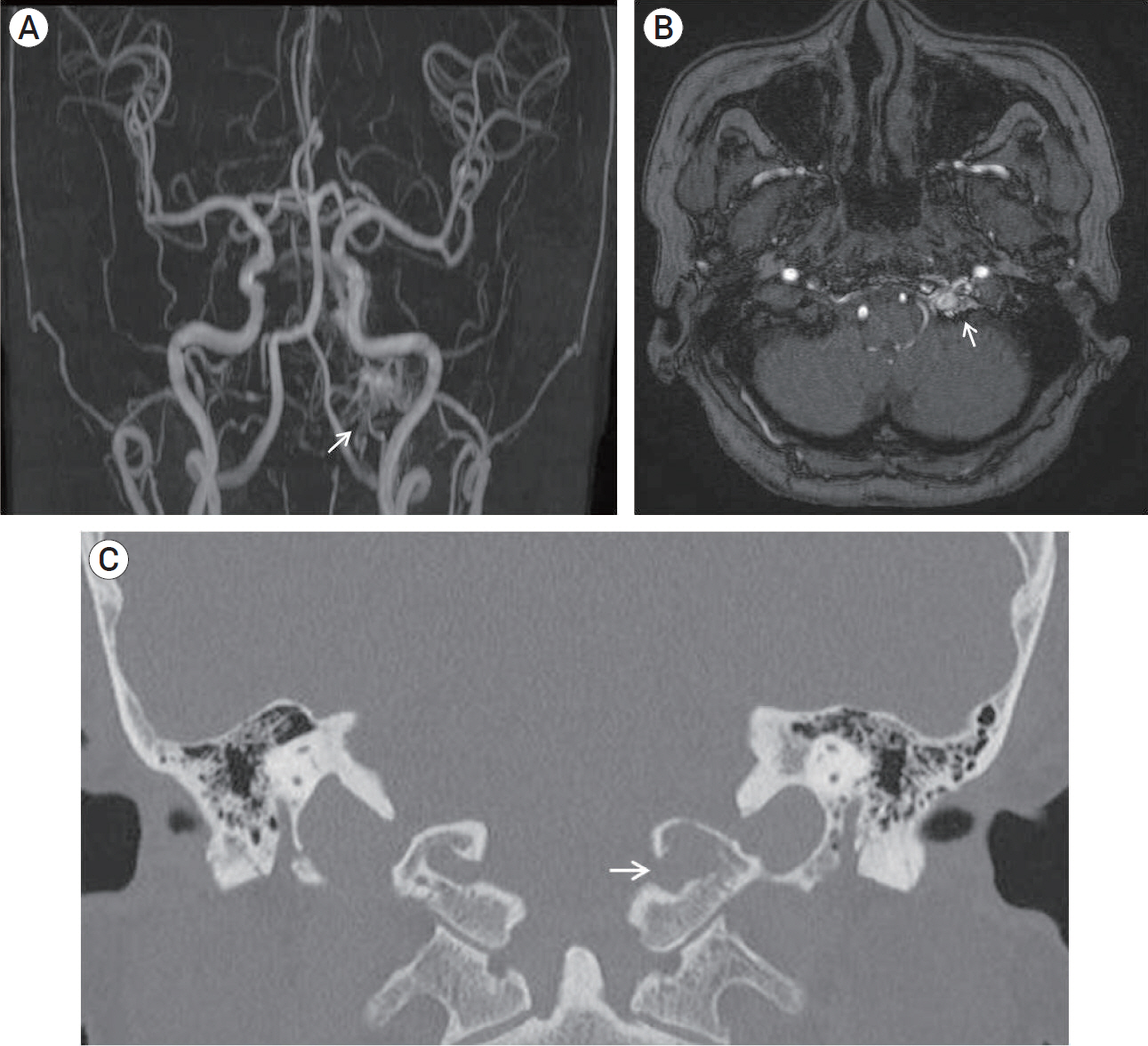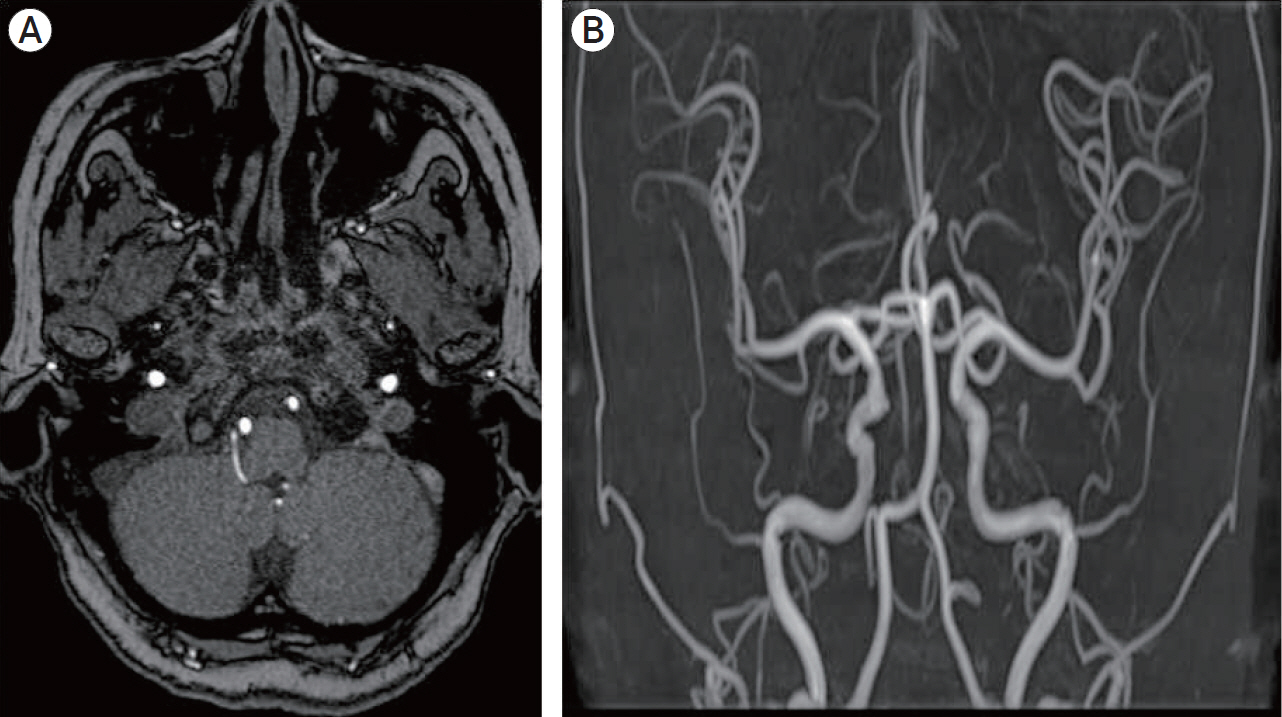J Cerebrovasc Endovasc Neurosurg.
2022 Jun;24(2):166-171. 10.7461/jcen.2021.E2021.08.004.
Transvenous coil embolization of hypoglossal canal dural arteriovenous fistula using detachable coils: A case report
- Affiliations
-
- 1Department of Neurosurgery, Hallym University Sacred Heart Hospital, Anyang, Korea
- KMID: 2531660
- DOI: http://doi.org/10.7461/jcen.2021.E2021.08.004
Abstract
- The hypoglossal canal (HC) is an unusual location of the posterior fossa dural arteriovenous fistula (AVF), which usually occurs in the transverse or sigmoid sinus. Herein, we report a case of HC dural AVF successfully treated with transvenous coil embolization using detachable coils in a 68-year-old woman who presented with headache and left pulsatile tinnitus for 2 months. Brain magnetic resonance imaging (MRI) and cerebral angiography revealed left HC dural AVF. The pulsatile bruit disappeared immediately after the procedure. Follow-up MRI showed complete disappearance of the fistula. Precise localization of the fistula through careful consideration of the anatomy and transvenous coil embolization using a detachable coil can facilitate the treatment for HC dural AVF.
Figure
Cited by 1 articles
-
In Vitro Head-to-Head Comparison of Flow Reduction between Fibered and Non-Fibered Pushable Coils
Jong-Tae Yoon, Boseong Kwon, Joon Ho Choi, Sun Moon Hwang, Mihyeon Kim, Sungbin Hwang, Yunsun Song, Deok Hee Lee
Neurointervention. 2024;19(1):31-38. doi: 10.5469/neuroint.2024.00031.
Reference
-
1. Barnwell SL, Halbach VV, Dowd CF, Higashida RT, Hieshima GB. Dural arteriovenous fistulas involving the inferior petrosal sinus: angiographic findings in six patients. AJNR Am J Neuroradiol. 1990; May. 11(3):511–6.2. Blomquist MH, Barr JD, Hurst RW. Isolated unilateral hypoglossal neuropathy caused by dural arteriovenous fistula. AJNR Am J Neuroradiol. 1998; May. 19(5):951–3.3. Choi JW, Kim BM, Kim DJ, Kim DI, Suh SH, Shin N-Y, et al. Hypoglossal canal dural arteriovenous fistula: incidence and the relationship between symptoms and drainage pattern. J Neurosurg. 2013; Oct. 119(4):955–60.
Article4. Combarros O, Alvarez de Arcaya A, Berciano J. Isolated unilateral hypoglossal nerve palsy: nine cases. J Neurol. 1998; Feb. 245(2):98–100.
Article5. Ernst R, Bulas R, Tomsick T, van Loveren H, Aziz KA. Three cases of dural arteriovenous fistula of the anterior condylar vein within the hypoglossal canal. AJNR Am J Neuroradiol. 1999; Nov-Dec. 20(10):2016–20.6. Manabe S, Satoh K, Matsubara S, Satomi J, Hanaoka M, Nagahiro S. Characteristics, diagnosis and treatment of hypoglossal canal dural arteriovenous fistula: report of nine cases. Neuroradiology. 2008; Aug. 50(8):715–21.
Article7. McDougall CG, Halbach VV, Dowd CF, Higashida RT, Larsen DW, Hieshima GB. Dural arteriovenous fistulas of the marginal sinus. AJNR Am J Neuroradiol. 1997; Sep. 18(8):1565–72.
Article8. San Millán Ruiz D, Gailloud P, Rüfenacht DA, Delavelle J, Henry F, Fasel JHD. The craniocervical venous system in relation to cerebral venous drainage. AJNR Am J Neuroradiol. 2002; Oct. 23(9):1500–8.9. Tanoue S, Goto K, Oota S. Endovascular treatment for dural arteriovenous fistula of the anterior condylar vein with unusual venous drainage: report of two cases. AJNR Am J Neuroradiol. 2005; Sep. 26(8):1955–9.
- Full Text Links
- Actions
-
Cited
- CITED
-
- Close
- Share
- Similar articles
-
- Transvenous injection of n-butyl 2-cyanoacrylate to obliterate the pathologic cavernous sinus as a salvage technique for incompletely obliterated complex cavernous sinus dural arteriovenous fistula after transvenous coil embolization
- A Case of Dural Arteriovenous Fistula of the Anterior Condylar Vein
- Transvenous Coil Embolization for Dural Arteriovenous Fistulas of the Ophthalmic Sheath: Report of Two Cases and Review of the Literature
- Dural Arteriovenous Fistula Involving Transverse Sinus: Successful Embolization Using Onyx(R)
- Transvenous Embolization in Patients with Dural Arteriovenous Fistula





